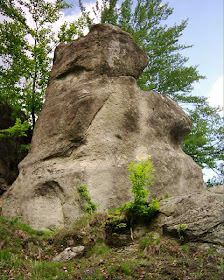Un clasic si superb MENHIR! Altar de cult pagan crestinat in Romania !?! Observati si Complexul Megalitic ... de vis-a-vis !!!
Sfinxul "Negru Voda" - Veghetor al Complexului Megalitic (?!?!)
Doua MENHIRE superbe in MAJESTATEA lor - dar ... uitate de oameni, napadite de vegetatie! De trei ori pacat!
Trecatorule, nu te speria! Este acolo, in singuratatea lui, de milenii
Greu explicabila complexitatea dispunerii Complexului Megalitic din Cetateni , Arges, Romania. Regret ca nu am gasit pe net PHOTO mai multe, profesional facute - in scopul cercetarii stiintifice
Reamintesc multumirile mele, celor care au postat PHOTO
Altar de cult? NU! Un clasic Altar de Sacrificiu
Locatia: Cetateni, Arges, Romania
In Legendele locului, se vorbeste de ... urmele pasilor Legendarului
Negru Voda
Altar ofrande
Altar sacrificiu?
Megaliti antropomorfi - Veghetori ai locurilor
sau ... mesageri ai zeilor ?!
Templu si Altar Megalitic in Cetateni, Arges, Romania
Mânastirea Cetatuia Negru-Voda sau Meteora României
Este aşezată pe piscul unui munte la altitudinea de 881 m de la nivelul mării între Valea lui Coman, Valea Chiliilor şi apa Dâmboviţei, la 25 km S-E de Câmpulung pe şoseaua ce vine de la vechea cetate de scaun a Târgoviştei, ancestral drum de cărăuşie în Ţara Românească.
P.S.: Recomand si aceasta postare:














MEGALITHIC MONUMENT
RăspundețiȘtergeremĕgəlĭthˈĭk [Gr.,=large stone], in archaeology, a construction involving one or several roughly hewn stone slabs of great size; it is usually of prehistoric antiquity. These monuments are found in various parts of the world, but the best known and most numerous are concentrated in Western Europe, including Brittany, the British Isles, Iberia, S France, S Scandinavia, and N Germany.
Aside from the standing stones and stone heaps that are still raised occasionally as boundary marks or memorials of personal and public events, most megalithic monuments seem to have been erected for funerary and religious purposes. The Western European megaliths were constructed during the Neolithic and the Bronze Age and are believed to range in date from c.4000 b.c. to 1100 b.c.
Most chamber tombs were probably built during the 4th millennium b.c., and the stone circles generally date somewhat later. Megalithic monuments may be divided into four categories: the chamber tomb, or dolmen ; the single standing stone, or menhir ; the stone row; and the stone circle. Chamber tombs were usually covered with earth mounds, forming a barrow. Menhirs sometimes stood alone near the entrance of a tomb or on top of the mound.
Sometimes they were set in long rows called alignments, as at Carnac in Brittany; in other places they were arranged in a circle, the most elaborate of which is Stonehenge in England (these are known as cromlechs outside Britain).
The individual stone slabs may reach 65 ft (20 m) in length and 100 tons (90 metric tons) in weight. Such massive structures testify to the engineering feats possible with the concerted efforts of relatively ill-equipped peoples.
See G. Daniel, The Megalith Builders of Western Europe (1958); A. Thom, Megalithic Sites in Britain (1967) and Megalithic Lunar Observations (1973); C. Renfrew, Before Civilization (1973); J. Mitchell,Megalithomania (1982); R. Joussaume, Dolmens for the Dead (tr. by A. and C. Chippendale, 1988).
Admin, ai dreptate! Lumea este interesata! Pacat ca noi nici nu vrem sa stim, dar sa facem turism de ... genul: calator prin lumea megalitilor din Romania!
Felicitari pentru blog, pentru ideea de a aduna macar asa, la un loc aceste comori lasate in voia soartei!
Imi cer scuze pentru anonimat, dar e mai bine asa!
Se putea sa nu-i pună (ca să nu folosesc un cuvant urat dar mult mai potrivit) o cruce, asa au profanat toate locurile sacre ale strămoșilor, ăștia cu religia lor abrahamica de import, fără de legătură cu tradiția moșilor și strămoșilor noștri!
RăspundețiȘtergere